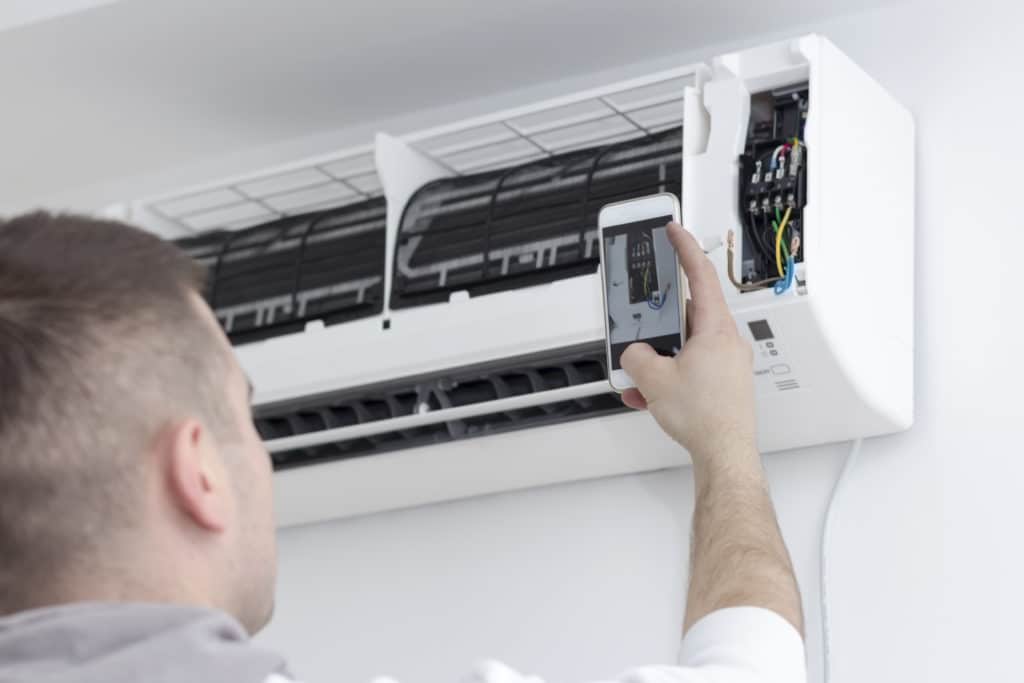Trade Expert Q&A Series: Chilling with Bruce Kniffin, Refrigeration

ServiceChannel’s four in-house trade specialists are no joke — but they’re pretty jovial guys who are always up for a casual and enlightening conversation about pipes, wires, coils, burners, and refrigerants. Considering it’s the vast expertise of these four gentlemen that helps keep ServiceChannel at the #1 spot for facilities management platforms, we think it’s a shame to keep them all to ourselves. So, during the month of May, Bruce, Tony, Millard, and Aaron will give us a little glimpse into what goes on behind the scenes as they work to keep your facilities operating at peak performance.
Bruce Kniffin has found himself in some mighty “cool” places during his 44 years in the refrigeration business. From chocolate chip and whipped cream factories to commercial mushroom farms and slaughterhouses, there aren’t many places with refrigeration needs that he hasn’t seen. A cold room for storing rivets used in aircraft manufacturing? Been there. Equipment repair at an Arctic Circle oil drilling site? Done that.
Bruce is about as laid back as any old-timer in the trades. Where less-seasoned trade specialists might get excitable over a never-before-seen problem, Bruce steps in with his calm, confident energy, like a doctor stepping out of the crowd to deliver a baby or a pilot’s trustworthy voice coming over the intercom during a stretch of turbulence to let you know that everything is going to be okay. Because even if Bruce hasn’t seen it (and he probably has), he’s seen enough to know exactly what to do.
And that’s why ServiceChannel is so happy to have Bruce on board as our subject matter expert in all things commercial refrigeration and beyond. He’ll tell it to you kindly, but he’ll give it to you straight. You can rest assured he knows what he’s talking about — and that he always has your back.
We caught up with Bruce, chilling at home in Nashville, over Zoom for a little Q&A session and came away with some valuable insight into what’s new and interesting in the world of refrigeration.
Bruce, has much changed during the 44 years you’ve been in the refrigeration industry?
[Chuckles] You know, when I first started, we had good, old-fashioned electromechanical machines that would put out cold air. Now we basically have computers that put out cold air. As far as operation goes, manufacturers make it easy for the user — on the level of an ATM machine, almost. But now technicians need a lot more technical training and skills to install and repair refrigeration equipment.So, what does a week in your life at ServiceChannel look like?
Well, trade specialists wear many hats — and there’s never a dull moment. Some of those hats are translator, expediter, auditor, approver, negotiator, teacher, ambassador, researcher, reporter — you name it. I spend a lot of my day reviewing proposals from service contractors. I either approve a proposal as-is and send it over to the client for their review and final go-ahead, or I send it back to the service contractor for revisions.
What would cause you to reject a proposal from a service provider?
When I review a proposal, I check for three main things: First, do I agree with the diagnosis? Is it accurate and complete?
Second, do I agree with the proposed remedy? Is it the most appropriate action to take, considering the age of the equipment, the cost of the service, and the time needed to complete the work?
And third, is the proposed pricing within the expectations for that market and within the rate card that the provider has previously submitted to ServiceChannel?
You mentioned all of the hats you wear on a given day. What’s your favorite chapeau?
Wow, that’s hard to answer. Perhaps translator. I enjoy taking highly technical information and translating it into concepts and language that a less-technical or non-technical person can understand. And I think it’s important to take the time to make sure a client really understands the problem and the solution.
One company I used to work for, they called me Mr. Wikipedia. They constantly asked questions about proposals, you know, like, What is this? What does this mean? What the heck are they talking about? And I’d tell them, oh, that’s just a motor, or that’s just a valve or whatever. And the light would come on, and they’d say, Ohhh! Okay.
So maybe translator is the best, I don’t know. They’re all interesting.
Besides refrigerators and coolers, what does a refrigeration expert such as yourself maintain, fix, or install?
Well, at grocery store locations, I’m usually also responsible for HVAC, since the same service contractor is generally used for both HVAC and refrigeration. I’m also responsible for some of the other lesser trades, like produce misters, cooling towers, doors, dock equipment, forklifts, pallet jacks, power washing, shopping carts, cart shade — things like that.
How do those lesser trades play into the broader umbrella of refrigeration?
Well, the thing to understand about how we operate is, there’s four of us trade specialists. We each have a major line that we take care of, but all of our clients have a lot of things to maintain in their facilities besides refrigeration, HVAC, plumbing, and electrical. They have flooring to take care of, they have ceilings, they have roofs.
So, we review those work orders as well, although not nearly on the scale that we do with the four major ones. What we’ve done between the four of us is split those minor trades up and take things that kind of match with our main lines.
So, there’s four of you — do you work very closely together? Are you all well-versed in all of the four trades?
We are, yeah. And we do work very closely together. Last week, Aaron was off, so Tony, Millard and I split up the lines that he has. This week, Millard is off on a boat somewhere, and Tony, Aaron and I split up his lines. We’re kind of a department within a department. We communicate often and share information — we pick each other’s brains on a regular basis.
And what does that look like?
Well, maybe one of us gets something odd or unusual, and we’ll reach out to one of the others or maybe the entire group and say, Hey guys, have you ever seen this before? Or, What do you think about this, guys? And usually, one of us knows the answer. With all of our backgrounds, one of us has either done it, seen it, or is at least familiar with it.
So, if something were to come up that was just outrageously bizarre, who would you go to if none of you had any experience with it?
Well, we all have a pretty big network of people we can call on. A lot of the people in my network are in manufacturing, involved with designing, building, and supplying the components and equipment we use in our industry. Oftentimes, we’ll reach out to those folks. Every manufacturer in our trade has a little department they call application engineering, those are the guys you go to when you’re stumped.
Speaking of manufacturers, let’s talk supply chain. What if you’re a supermarket, and your freezers go out, and you can’t get the parts you need for three weeks. What happens? Does the store have to shut down frozen foods until the goods arrive?
Well, there’s a technical term for what we experts do in this situation — and maybe you’re familiar with it — it’s called “MacGyver it.”
Haha! Paperclips and bubble gum!
Right! But seriously, there is always a way around the supply chain. You may need to use parts that you normally wouldn’t use, or rig something up that you wouldn’t do routinely — but there’s a way to make a system run temporarily.
You know, I was telling you about the many hats that we wear and one of them being an expediter. A lot of times, we’ll get a proposal from a contractor, and they’ll say, here’s the proposal, but it’s going to take us three weeks to get the part we need for this ice machine or whatever.
And that’s when the fun button turns on for me because that’s what my background is. That’s what my industry is. That’s what my network is. I love the challenge of getting that ice machine working in the next 24 to 48 hours, period.
Do you ever blow the minds of younger or less experienced technicians with your killer MacGyvering skills?
Kind of — I’ll call them up and say, well, why don’t we do this? And oftentimes, their reaction will be, you know, that’s not how it’s done, that’s not how they build them at the factory. And I’ll say, well, that’s okay. We’ve got a client who’s got a business to run, and they can’t close their store down because we can’t find the exact perfect identical part that we’re taking off. And they’ll say, oh, okay.
I’m aware of a supermarket that had an issue with a water heater. And grocery stores today, they’re almost like a restaurant, right? I mean, you can buy freshly made pizzas, fried chicken, that kind of thing. Their water heater went out and they didn’t have any hot water in the building. Without running hot water, a business serving food cannot operate. So, they had to close down for a day. And the issue was that the service provider claimed they couldn’t get the part they needed locally, so they had to wait until the new part shipped.
And you know, we just can’t let that happen. We have to find a way to make it work — and it can be done. It just takes a little gumption, creativity. A little enthusiasm, thinking outside the box.
For me — for us — it’s not really a big issue if a part is held up somewhere because of the supply chain. My background is with wholesale distributors, and most of my career has involved specifying parts, choosing parts, finding parts, and selling parts. There’s quite a robust aftermarket business involved in parts, so getting one that’s “unavailable” is just a matter of knowing where to find it.
And do you always find it?
I can’t claim a hundred percent success, but almost always, when I’m told we can’t get a part for weeks, I will go, and I will find that part somewhere, somehow, and it’ll be in our hands the next day. Or I’ll find a part that will work in that same application with a little modification — and it’s sitting on somebody’s shelf right now, and they can ship it overnight.
I had a job years ago in St. Louis. It was late in the day, and we had to have a part by the following morning. Everybody’s like, oh, we can’t get anything shipped, all the factories close at 4:30 pm, you know, there’s no way we can do this. And I said, wait a minute. I said, I know this company based in Chicago that has a warehouse on the West Coast, where it’s two hours earlier. We placed the order and had it shipped next-day air. Problem solved. That’s usually how it goes.
So, aside from supply chain issues, what’s going on for commercial refrigeration in 2022? What’s the buzz around town, the word on the street?
I’d say the biggest news this year is around natural refrigerants — you know, things that occur in nature. The latest and perhaps ultimate of these is carbon dioxide, or CO2 — also known as R744. It’s just beginning to be used in supermarkets — it’s actually becoming fairly popular for larger systems. The other natural refrigerant is propane, which is becoming more popular in smaller, self-contained equipment. That one is known as R290. Another big buzz is the new regulations coming into effect soon for conventional refrigerants.
When the EPA changes regulations, are there times when companies have to completely gut all of their equipment and install new models to be in compliance, or are the new regulations grandfathered in?
There are ways to be in compliance with new EPA regulations without having to replace all of the equipment. Generally, what happens is, the EPA will announce far in advance that, hey, you know, we’re looking at phasing out this refrigerant or this class of refrigerants. And so all of the refrigerant manufacturers immediately start working on new refrigerants.
And, oh my goodness. We’ve been through so many versions of this. I mean, there are good, legitimate reasons why the EPA issues new regulations, especially in light of global warming, but you just can’t imagine how many times we’ve done this drill. It’s remarkable.
So, can equipment be retrofitted for CO2, or does it require entirely new equipment?
No, CO2 equipment is unique — and it’s expensive. In general, you’re only going to find a CO2 system going into new stores, because when they’re putting one in from the ground up in a new construction, companies can deal with the budgetary challenges more easily.
Would an existing store switch to CO2 once it’s time to replace their current system?
Probably not. An existing store would probably never switch to CO2. I mean, it could — it’s not impossible — but it’s unlikely, because that would be a huge, massive, very, very expensive undertaking. CO2 systems are probably only going to be found in new construction.
One last question: If you could give a facilities manager the golden egg of refrigeration advice that would save time, money, and heartache, what would it be?
That’s easy. It would be strict, mandatory, extensive preventative maintenance. In the simplest of terms, preventive maintenance is just inspecting and cleaning all areas of a refrigeration system without cutting corners. During a routine maintenance call, parts that have a suspected short lifespan are replaced right then instead of waiting until they fail — and they always fail at the worst possible time, and the repair is far more expensive than just replacing a part before it gets to that point. One of my favorite sayings is “preventative maintenance doesn’t cost – it pays.”
Check in next week to meet Millard Wilson, our commercial kitchen equipment expert who’s got his fingers on the pulse of what’s cooking in that industry.
Want to be the first to know when we publish our next Q&A? Join our mailing list and subscribe to our blog.



